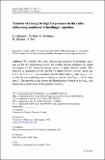Transfer of energy to high frequencies in the cubic defocusing nonlinear Schrodinger equation
Author(s)
Colliander, J.; Keel, M.; Staffilani, Gigliola; Takaoka, H.; Tao, T.
DownloadStaffilani_Transfer of.pdf (1.364Mb)
PUBLISHER_CC
Publisher with Creative Commons License
Creative Commons Attribution
Terms of use
Metadata
Show full item recordAbstract
We consider the cubic defocusing nonlinear Schrödinger equation on the two dimensional torus. We exhibit smooth solutions for which the support of the conserved energy moves to higher Fourier modes. This behavior is quantified by the growth of higher Sobolev norms: given any δ[much less-than]1,K [much greater-than] 1, s > 1, we construct smooth initial data u 0 with ||u0||Hs , so that the corresponding time evolution u satisfies u(T)Hs[greater than]K at some time T. This growth occurs despite the Hamiltonian’s bound on ||u(t)||H1 and despite the conservation of the quantity ||u(t)||L2.
The proof contains two arguments which may be of interest beyond the particular result described above. The first is a construction of the solution’s frequency support that simplifies the system of ODE’s describing each Fourier mode’s evolution. The second is a construction of solutions to these simpler systems of ODE’s which begin near one invariant manifold and ricochet from arbitrarily small neighborhoods of an arbitrarily large number of other invariant manifolds. The techniques used here are related to but are distinct from those traditionally used to prove Arnold Diffusion in perturbations of Hamiltonian systems.
Date issued
2010-04Department
Massachusetts Institute of Technology. Department of MathematicsJournal
Inventiones Mathematicae
Publisher
Springer-Verlag
Citation
Colliander, J. et al. "Transfer of energy to high frequencies in the cubic defocusing nonlinear Schrödinger equation." Inventiones Mathematicae (2010) 181.1, p.39-113.
Version: Final published version
ISSN
0020-9910
1432-1297